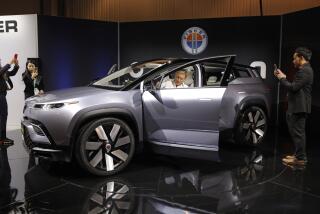Tata’s $2,500 Nano an object of fascination for rival carmakers
- Share via
Detroit — If you build a better mousetrap, the world will beat a path to your door. If you build a new car for $2,500, the world’s automakers will drive a semi to your loading dock so they can take it home and study it.
Of course, you may want to have somebody watching to make sure they don’t strip the car to its bolts and learn all your secrets.
A stream of executives and engineers has been visiting Tata Technologies in Novi, Mich., to see the Nano, the 10-foot-long, five-passenger car the engineering consulting firm helped its affiliate Tata Motors develop. Tata Tech has also lent the car to manufacturers so more engineers can get a close look.
“It’s a very useful calling card,” Tata Tech engineering and design chief Kevin Fisher said. Industry veterans don’t believe it’s possible to make a $2,500 car until they walk around the Nano. Nearly 2 feet shorter than a Mini Cooper, the Nano was developed as India’s version of the Ford Model T, the affordable car that put a country on wheels.
The visitors don’t necessarily plan to build a car for the Nano’s price. They want to apply Tata’s “frugal engineering” philosophy to their product lines.
“It’s a thought process,” Fisher said. “You start from scratch and ask, ‘What do I really need?’ ”
Nano development began when Tata Chairman Ratan Tata decided the company that bears his name should provide a better, safer alternative to the motorbikes that frequently carry whole families in India.
“Ratan Tata said, ‘If we start from zero and build up, how much can we get for $2,000?’ ” said Kevin Power, a manager at Tata Tech in Novi. “That was the philosophical basis of the design. Other automakers tend to start with an existing vehicle and take stuff out to reduce the price.”
At $2,500 for a top-of-the-line model, though, there is a lot of stuff missing from the Nano. Air bags, emission controls and a radio, for instance. The Nano can’t meet U.S. safety and emissions requirements, though Tata hopes to sell a better- equipped model here.
Though established automakers may not match the bare-bones Nano, they’re studying the process that created it.
Power calls it lean engineering: “What content can we put in, and how do we make it inexpensive?” Examples include using identical hinges for all four doors and securing the carpet with Velcro.
A lot of savings come in manufacturing. The Nano’s steel body panels have simple shapes than are inexpensive to make. The tools to produce the panels were designed to last three or four times the standard life.
Tata’s factory aims to produce 500,000 Nanos annually. Independent assemblers in India may eventually build another 500,000 a year.
The main factory will weld the bodies together and ship them in kits to remote villages for final assembly. The businesspeople who build the cars will also sell and service them.
Tata frowns upon other automakers’ taking its car apart, however. That’s why Tata Tech’s display Nano gets strict supervision when it’s on loan.
Phelan writes for the Detroit Free Press/ McClatchy.





